

Interactive Metabolic Pathways Map. Cell Biology – Life Science Interactive. The Human Protein Atlas. Homeostasis - kidneys and water balance. Substances are moving in and out of the cells of your body all the time.
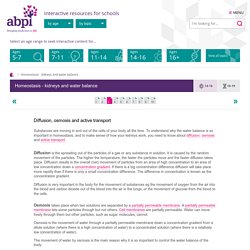
To understand why the water balance is so important in homeostasis, and to make sense of how your kidneys work, you need to know about diffusion, osmosis and active transport. How Do Cells Make Proteins. Facebook. Cell Signaling Technology. Cellmem. "Synthesis of ATP" – Drew Berry and Franc Tétaz (2018) Enzyme Lab. Name:________________________________________ Date:__________ Objectives Measure the effects of changes in temperature, pH, and enzyme concentration on reaction rates of an enzymeExplain how environmental factors affect the rate of enzyme-catalyzed reactions.
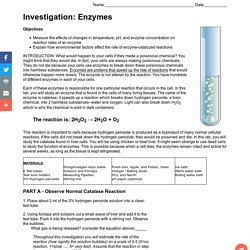
INTRODUCTION: What would happen to your cells if they made a poisonous chemical? You might think that they would die. In fact, your cells are always making poisonous chemicals. Each of these enzymes is responsible for one particular reaction that occurs in the cell. The reaction is: 2H2O2 → 2H2O + O2 This reaction is important to cells because hydrogen peroxide is produced as a byproduct of many normal cellular reactions. PART A - Observe Normal Catalase Reaction 1. 2. Throughout this investigation you will estimate the rate of the reaction (how rapidly the solution bubbles) on a scale of 0-5 (0=no reaction, 1=slow, ..... 5= very fast).
Has it gotten warmer or colder? 3. Test this and record the reaction rate. 4. Evidence: How Enzymes Work. Transkrypcja i translacja – znaczenie pojęć – Biologia Vademecum Edukacja. Często spotykam się z upraszczaniem, myśleniem skrótowym w biologii, a szczególnie dotyczy to procesów na poziomie molekularnym.
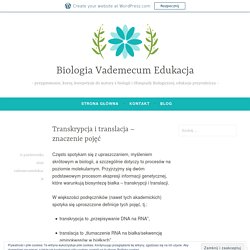
Przyjrzyjmy się dwóm podstawowym procesom ekspresji informacji genetycznej, które warunkują biosyntezę białka – transkrypcji i translacji. W większości podręczników (nawet tych akademickich) spotyka się uproszczone definicje tych pojęć, tj. (3) Twoje komórki. (10) STD 06 _ Science - Amazing Process Of Photosynthesis. KEGG PATHWAY: Metabolic pathways - Homo sapiens (human) 5 Creative Ways to Teach the Cell. 5 Creative Ways to Teach the Cell 1. 3 D Cell – this is a standard project for entry level biology classes, where students use various objects from around the house to design a three dimensional cell.
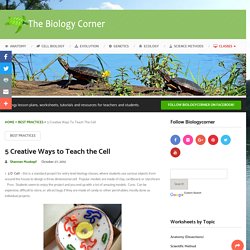
Popular models are made of clay, cardboard, or styrofoam. Pros: Students seem to enjoy the project and you end up with a lot of amazing models. Cons: Can be expensive, difficult to store, or attract bugs if they are made of candy or other perishables, mostly done as individual projects. 2. 3. More Cells Created by Students 4. 5. Molecular Expressions Microscopy Primer: Specialized Microscopy Techniques - Fluorescence Digital Image Gallery - Human Bone Osteosarcoma Cells (U-2 OS) Fluorescence Digital Image Gallery Human Bone Osteosarcoma Cells (U-2 OS Line) The U-2 OS cell line, originally known as the 2T line, was derived from the bone tissue of a fifteen-year-old human female suffering from osteosarcoma.
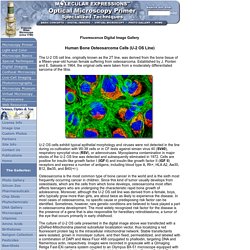
Established by J. Ponten and E. Saksela in 1964, the original cells were taken from a moderately differentiated sarcoma of the tibia. U-2 OS cells exhibit typical epithelial morphology and viruses were not detected in the line during co-cultivation with WI-38 cells or in CF tests against simian virus 40 (SV40), respiratory syncytial virus (RSV), or adenoviruses. Osteosarcoma is the most common type of bone cancer in the world and is the sixth most frequently occurring cancer in children. The culture of U-2 OS cells presented in the digital image above was transfected with a pDsRed-Mitochondria plasmid subcellular localization vector, thus localizing a red fluorescent protein tag to the intracellular mitochondrial network. Questions or comments? Lekcja 15. Cykl komórkowy. Cykl komórkowy Interfaza i Faza Podziału. Cell Cycle (Overview, Interphase) PDB-101: About Molecule of the Month. The RCSB PDB Molecule of the Month by David S.
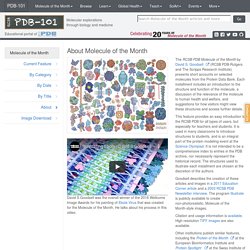
Goodsell (RCSB PDB-Rutgers and The Scripps Research Institute) presents short accounts on selected molecules from the Protein Data Bank. Each installment includes an introduction to the structure and function of the molecule, a discussion of the relevance of the molecule to human health and welfare, and suggestions for how visitors might view these structures and access further details. This feature provides an easy introduction to the RCSB PDB for all types of users, but especially for teachers and students. It is used in many classrooms to introduce structures to students, and is an integral part of the protein modeling event at the Science Olympiad. It is not intended to be a comprehensive index to entries in the PDB archive, nor necessarily represent the historical record. Goodsell describes the creation of these articles and images in a 2017 Education Corner article and a 2003 RCSB PDB Newsletter interview.
Inside the Living Cell - Animation 3D. Biology: Cell Structure I Nucleus Medical Media. Photosynthesis Lab. Nature's smallest factory: The Calvin cycle - Cathy Symington. ATP & Respiration: Crash Course Biology #7. Fermentation.